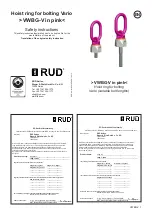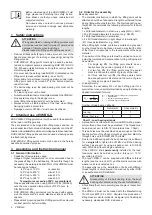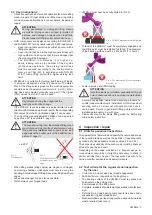
VWBG-V 3
3.3 User instructions
• Check frequently and before each operation the whole lifting
mean in regard of linger ability as a lifting mean, regarding
corrosion, wear, deformation etc. (see chapter 4, Inspection /
repair).
ATTENTION
Wrong assembled or damaged lifting means
as well as improper use can lead to injuries of
persons and damage of objects when load falls.
Please inspect all lifting points before each use.
• RUD components are designed according to DIN EN 818
and DIN EN 1677 for a dynamic load of 20,000 load cycles.
• Keep in mind that several load cycles can occur with a
lifting procedure
• Keep in mind that, due to the high dynamic stress with
high numbers of load cycles, that there is a danger that
the product will be damaged
• The BG/DGUV recommends: For higher dy-
namic loading with a high number of load cycles
(continuous operation), the working load stress
must be reduced according to the driving mecha-
nism group 1Bm (M3 in accordance with DIN EN
818-7). Use a lifting point with a higher working load
limit.
• VWBG-Vs are suitable for turning and flipping of loads.
In doing so, all positions of the ring can occur. The stated
WLL at the lifting point is given for the most inappropriate
possible case of operation (see picture 8 - part X). When
ring has been adjusted manually (see part Y) the higher
(WLL) values from chart 3 can be used
ATTENTION
Pay attention during the usage that the
load type will not be change.
If the VWBG-V is will be loaded only perpendicular (in axial
direction of the thread, see picture 8 - part Z) the corresponding
WLL values from chart 3 (inclination angle 0°) can be used.
• The ring of the manually adjusted VWBG-V can be pivoted
by approx. 230° (see picture 1, page 3).
ATTENTION
The suspension ring resp. the attached lifting mean
must rotate and pivot without interference during
lifting and must
neither
have support at the load
edge
nor
at the bottom part of the VWBG-V (see
picture 2, page 3).
Pic. 1:
Pivoting area /
Pic. 2:
Forbidden contact
or support at/or with
edge
ca. 230°
• When lifting means (sling chains) are hinged or unhinged,
no pinching, shearing or joint spots must occure during the
handling. Avoid damage of lifting means resulting from sharp
edges.
• Leave direct danger zone as far as possible.
• Watch always your hinged loads.
• VWBG-V must have been fully bolted in (Pic. 3).
Pic.3: VWBG-V must have been fully bolted
in
• Thread of the VWBG-V must be completely engaged and
the lifting point must be installed full-faced. (The diameter
of the bearing surface must be ≥ D, see Pic. 4 / chart 2).
Pic. 4: The diameter of the bearing surface
must be ≥ D
• Avoid impulsive and tiltful loading.
ATTENTION
Impulsive loading or vibration, especially at through
hole connections with nuts, can lead to unintentional
loosening.
Securing possibilities: liquid thread securing products f.e.
Loctite (read manufacturer´s instruction) or form closed bolt
securing such as a crown nut with split pin, lock nut etc.
can be used. Secure in general all lifting points which are
installed permanently, e.g. with glue.
• Please observe for the whole lifting mean the RUD sling
chain safety instruction.
4 Inspection / repair
4.1 Hints for periodical inspections
The operator must determine and specify the nature and scope
of the required tests as well as the periods of repeating tests
by means of a risk assessment (see sections 4.2 and 4.3).
The continuing suitability of the anchor point must be checked
at least 1x year by an expert.
Depending on the usage conditions, f.e. frequent usage, in-
creased wear or corrosion, it might be necessary to check in
shorter periods than one year. The inspection has also to be
carried out after accidents and special incidents.
4.2 Test criteria for the regular visual inspection
by the user
• Correct bolt- and nut size plus thread engagement
• Solid bolt fixture - Inspection of bolting torque
• The bearing surface of the VWBG-V must lay plane and
holohedral on the bolting area.
• Completeness of the lifting point
• Complete, readable WLL statements as well as manufacturer
sign.
• Deformation at load bearing components like base body,
suspension ring and threaded pin.
• Mechanical damage, like strong notches, especially in areas
where tensile stress occurs.























